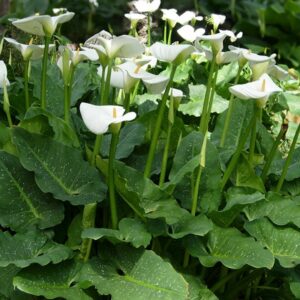Your cart is currently empty!
Hardy Calla Lily: A Resilient and Beautiful Addition to Your Garden

Introduction
Hardy calla lilies (Zantedeschia aethiopica) are captivating plants that bring elegance and charm to gardens with their striking blooms and lush foliage. Unlike their more tender counterparts, hardy calla lilies are renowned for their resilience, tolerating colder temperatures and thriving in various climates. This comprehensive guide will delve into the enchanting world of hardy calla lilies, exploring their characteristics, cultivation requirements, and blooming season.
Characteristics of Hardy Calla Lilies
- Stunning Blooms: Hardy calla lilies produce magnificent funnel-shaped flowers with a central spadix surrounded by a showy spathe. The spathes can range in colour from pure white to vibrant yellow, pink, and purple.
- Upright Foliage: These plants feature upright, arrow-shaped leaves with smooth edges and a deep green colour. The foliage adds a lush, verdant backdrop to the eye-catching blooms.
- Height and Spread: Hardy calla lilies typically grow to a height of 1-3 feet and spread 1-2 feet, making them suitable for borders, containers, and mass plantings.
- Cold Hardiness: One of the defining characteristics of hardy calla lilies is their cold hardiness. Most varieties can tolerate temperatures as low as USDA Hardiness Zone 7 (-17.8°C to -12.3°C), making them adaptable to a wide range of climates.
Cultivation Requirements
To ensure thriving hardy calla lilies, it’s essential to provide them with their preferred growing conditions:
Soil
- Well-Drained: Calla lilies prefer well-drained soil that is rich in organic matter. Amend heavy clay soils with compost or other organic materials to improve drainage.
- pH: They thrive in slightly acidic to neutral soil with a pH range of 6.0 to 7.0.
Sunlight
- Partial Shade: Hardy calla lilies prefer partial shade, receiving bright, indirect sunlight for several hours daily.
- Avoid Direct Sun: Too much direct sunlight can scorch the leaves and hinder blooming.
Watering
- Regular Watering: Water regularly, especially during active growth and flowering. Keep the soil consistently moist but not waterlogged.
- Avoid Overwatering: Overwatering can lead to root rot, so allow the top few inches of soil to dry out slightly before watering again.
Fertilization
- Fertilize Regularly: Feed hardy calla lilies with a balanced liquid fertilizer every few weeks during the growing season.
- Avoid Excess Nitrogen: Too much nitrogen can promote excessive foliage growth at the expense of flowering.
Blooming Season and Care
Hardy calla lilies typically bloom in the spring and early summer. Here’s how to care for them during and after blooming:
Deadheading
- Remove Spent Blooms: Deadhead spent blooms to encourage new flower production.
- Cut Back Stems: Once blooming is finished, cut back the spent flower stalks to the base of the plant.
Dormancy
- Natural Dormancy: In fall, hardy calla lilies enter a natural dormancy period.
- Dig Up Bulbs (Optional): In colder climates, you can dig up the bulbs and store them in a cool, dry place over winter.
Revival in Spring
- Replant Bulbs: In spring, replant the bulbs in well-prepared soil when the threat of frost has passed.
- Water and Fertilize: Water deeply after planting and fertilize lightly to encourage new growth.
Popular Hardy Calla Lily Varieties
Numerous hardy calla lily varieties offer a range of colours and sizes. Here are a few popular selections:
| Variety | Spathe Colour | Height |
|---|---|---|
| ‘Green Goddess’ | Green | 2-3 feet |
| ‘Mango’ | Bright Orange | 2-3 feet |
| ‘Odessa’ | White with Yellow Spathe Inside | 1-2 feet |
| ‘Pink Diamond’ | Soft Pink | 1-2 feet |
| ‘Violet Gem’ | Deep Purple | 2-3 feet |
Tips for Growing Hardy Calla Lilies
- Choose Healthy Bulbs: Select plump, firm bulbs that are free of damage or disease.
- Plant Shallowly: Plant the bulbs with the pointed end up, just below the soil surface.
- Protect from Snails and Slugs: These pests can damage the leaves and flowers of calla lilies. Use snail and slug repellent products or create barriers to keep them away.
- Avoid Overcrowding: Space the bulbs 8-12 inches apart to allow for good air circulation and prevent disease.
- Mulch Around Plants: Mulch around calla lilies to retain moisture, suppress weeds, and regulate soil temperature.
Conclusion
Hardy calla lilies are captivating plants that bring elegance and charm to gardens with their striking blooms and lush foliage. By providing them with their preferred growing conditions and following the care tips outlined in this guide, you can enjoy these resilient and beautiful flowers for many seasons to come. Whether planted in borders, containers, or mass plantings, hardy calla lilies are sure to add a touch of sophistication and beauty to your outdoor space.








Leave a Reply